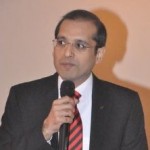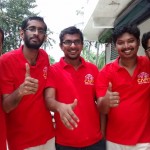Daniel Varghese – Founder of Wrench Solutions was a passionate Mechanical Engineer. He started his business right out of college and started by interacting with Engineering companies by doing small service work. While doing these small projects, his conversation with his customers led to the fact that his customers had a pain working in a collaborative way within and outside the organization in building machines. He defines Collaboration as a way that within an engineering division, they have multiple stakeholders such as a designer, reviewer, approver and there is a hierarchy of information that exchanges information which needs to be given to another department that has to be processed and is given back if they are unable to process and the cycle continues. This entire cycle was working in silos but they had a latent need to exchange information instantaneously and he found an opportunity to make it electronic so that the cycle time between departments for exchange of information is instantaneous.
Daniel created a PowerPoint presentation (had no product) from listening to the prospects and understood that this could be a common problem for anyone who is working between a designer and a manufacturer. He went to his first prospect and spoke about the pain points that his product can solve and listening to the prospects added features, he went to the next company in the similar industry and spoke about the added sheet of problems and So he went to one company, listened, created a PPT, went to another one, listened , went to anther and after sometime he learnt the issues for the industry so well and customers were very happy to find someone who understood the practical problems and the technology challenges in the industry. His pitch to his prospects were “I guess you should be having this problem and I will be able to solve it for you, can we talk?. This question opened up lots of interesting conversations and helped him build the product. This product was not existing, he created the products out of customer’s needs and there was no reference or competition. So it was either paper based or this product and he had to create a market for this. He had to establish a trust with the customer by demonstrating his domain knowledge and he consistently made sure that he delivered what he promised and things began moving in a positive direction.
In his initial days without the product, he wanted to build relationships with his customer segment and innovated a unique way to do so. He became a reseller of Auto CAD first and began building a relationship with his Buyer Persona – The Department Managers within Engineering Organizations and built a credibility as a trustful partner who delivered on time, trained the employees well and kept his words. When he went in with his product idea, the department managers happily took him to their General Managers with a stamp of being a reliable vendor in the past and recommended him. The barriers to entry business were very high because the engineering folks don’t have faith in IT products because they are used to working on paper and found it difficult to believe that their manual drawing , documenting and commenting can be done effectively using technology. Being a mechanical engineer, he knew their psychology and began establishing credibility and built their faith in technology and give practical examples of how he solved the problem for someone else in a non-technical manner and they began listening to him.
Daniel did not have the funds and hence needed a customer and their money to build the product. He also knew that unless a customer pays , they will not spend time with you and hence will not give you a serious feedback. After doing a math on what would be a good amount that will be easy for a GM to take the risk on his new product, he went to his prospective customer and asked for INR 5 lakhs as 50% advance. The customer said they can start immediately if the payment can be delayed but Daniel stood to his feet for six months for the sake of payment and this policy of taking advance became the company’s standard. If he cannot get the money and he has to pay salary and rent and the focus of the founder changes and one can’t build a company. Get things in your terms on a reasonable way. Win-Win way of deals. He got the money and began hiring his team and built the product and demonstrated the prototype. The customer,( a German company) spent time and they were meticulously detailed in their feedback and they revised the prototype 6 times before the final implementation happened. The product got developed at the cost of a customer and he learnt the problems by interfacing with the customer and got the product. That was the starting point. Because they had a money from the customer, they were able to fund it and still make a small profit. This customer was so persistent in getting this product done well because they paid for it. That model of the customer paying advance continues till today and the product expanded from Small companies to Medium to Large enterprise customers with big volumes. Daniel understood the business issues and how to solve and his head of R&D goes and builds the solutions based on the logic of how they arrive at a method to solve the problem.
After having understood his first customer problem and analysing it thread bare and converting the customers process from that of paper to automation from an engineering department to other departments, he began communicating this deep knowledge with other customers as he realized that the problem of one customer to be constant with the other companies in the industry as this product was new to the market. He extrapolated the first customer problem to an inter-department problem and also with other vendors. He also understood the integration issues between departments and his knowledge of his first customer starting with his engineering department and then with other departments.
He did not build this company to sell within a few years but to create value and a product to add value to the industry, to make money and also have a sustained revenue through his maintenance contract and as long as people keep using, the company will survive only on AMC. The Indian way of people starting is what price can you sell, how much will you pay me for my company and when at this attitude is not right because they create value to their company and not to their customer. The minute you do that, you will not be faithful to your customer. The external thing is people think you are doing a great job but it is extremely critical and people come back for maintenance.
Daniel’s Advice to startup founders – Focus!!!. You have to believe that the problem you are solving is excellent to the customer . This should not solve just a symptom but should solve a disease . If you are solving a problem only skin deep, then anyone can create a product and can become your competitor, but if you understand the root cause, then you deliver value to the customer and make it difficult for your competitors. This will demonstrate that you are 100% committed and if you are articulate in communicating this to the customers, you have a solid edge. Never do anything free, your customers are not serious if they are not paying. No one will give you free feedback. You should believe that you can solve something great and you will convey that in all forms and get paid. The customers will then be committed because they have to justify the spend to their management. They will also be serious in helping you. Daniel coincidentally also explored giving the product free to the customers because they could not pay for it at that time but found that it loses steam. There is no free lunch and you have to convince your customer on paper and then engage with the customer. Spend as much time as you need to in researching the market and their needs on paper but never build a solution if the customer is not paying for it. Business on paper has no value if there is no cash.
Wrench(http://wrenchglobal.com), over the last 18 years has around 120 people and 140 customers with over 5000 users which includes the who is who of the manufacturing industry in India and a few large F1000 enterprises in the rest of the world. WRENCH also established six 100% owned subsidiaries globally. They had a funding from Technology Development Board of Government of India. WRENCH picked up the National award for Enterprise Application – SCOCH where one of their flagship customer(BHEL) presented how WRENCH changed their workflow and got the gold medal for the presentation. Times of India awarded Varghese Daniel as a Business Icon from IT and ITES in Kerala






